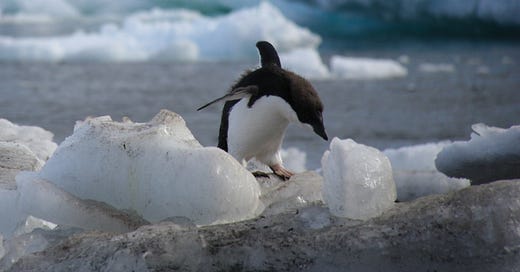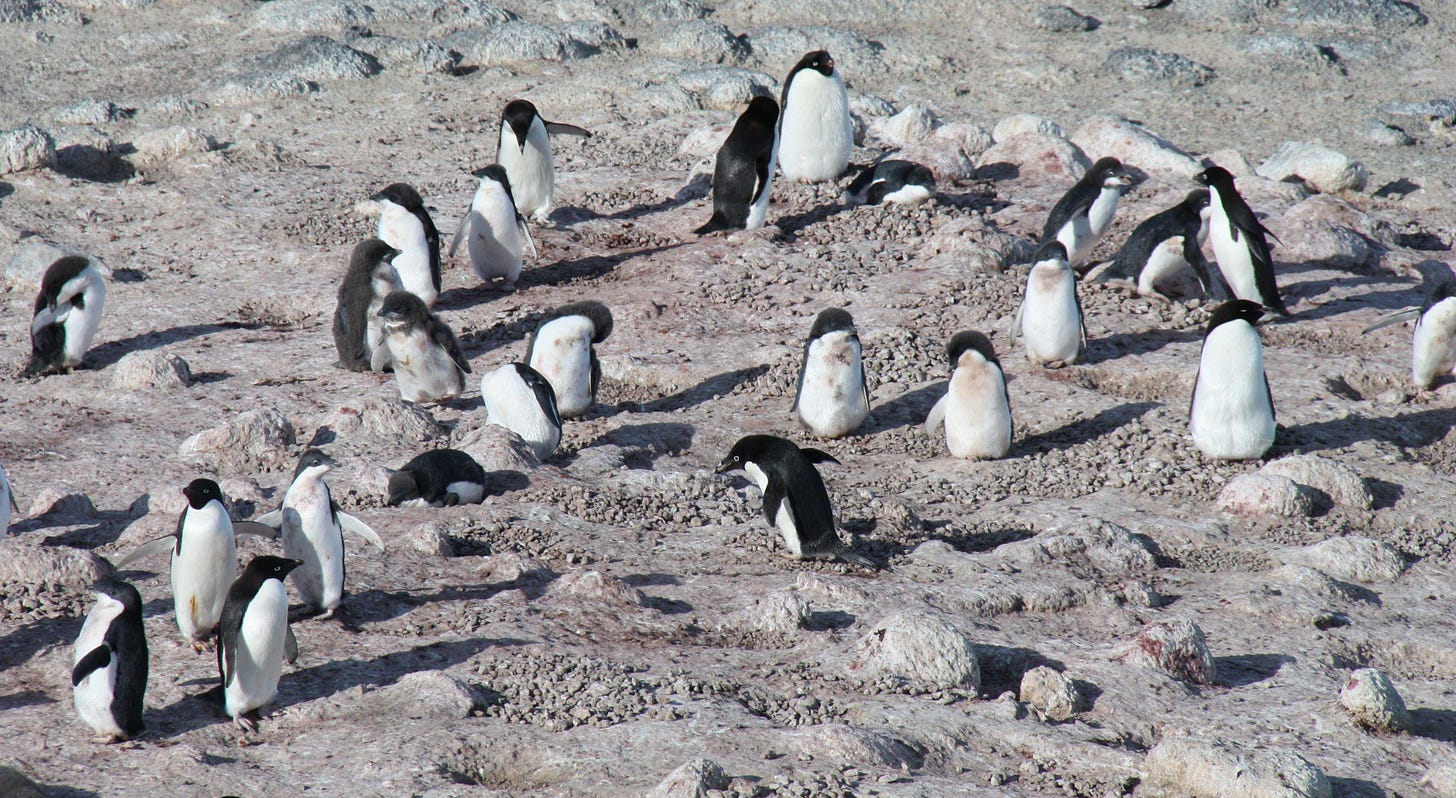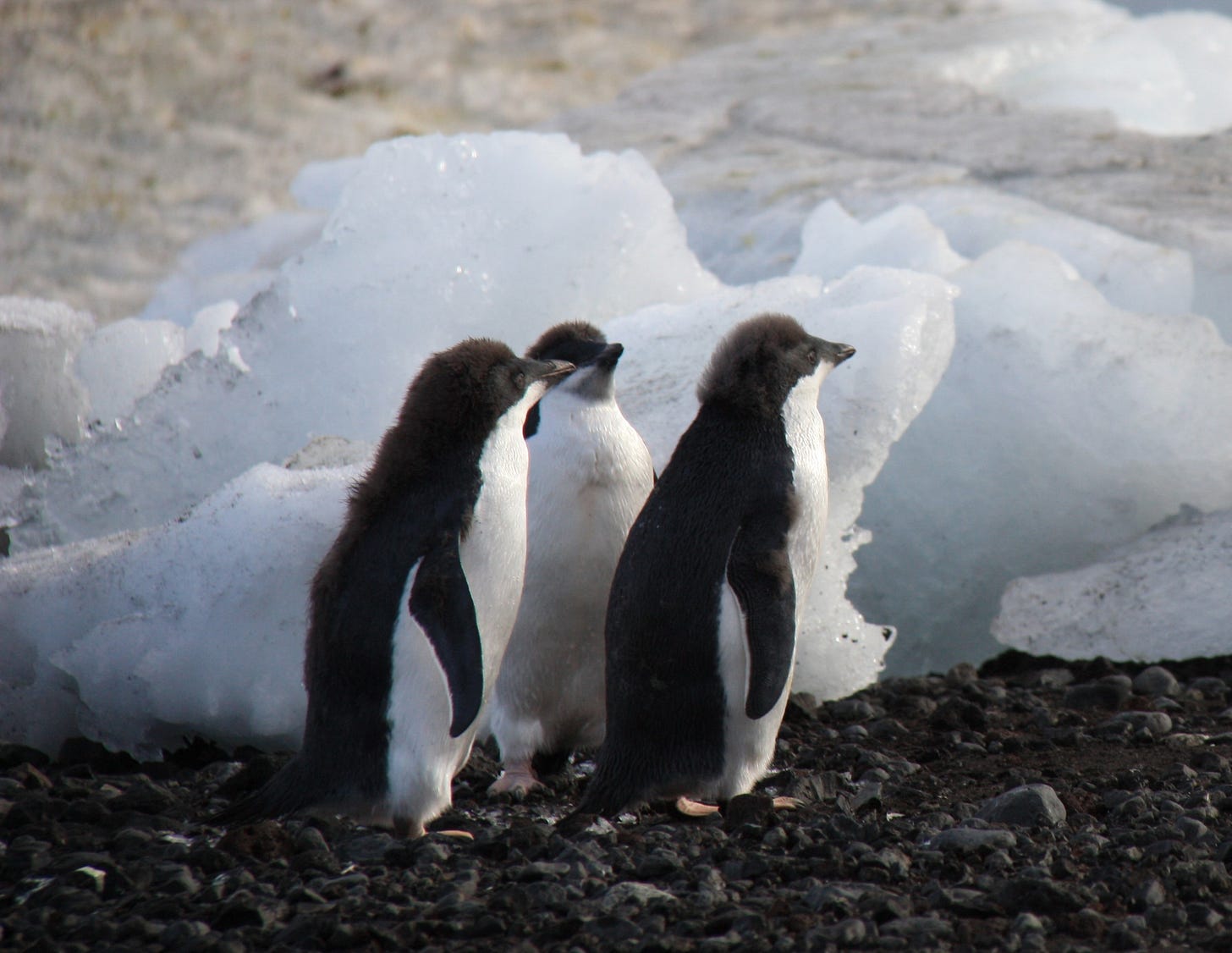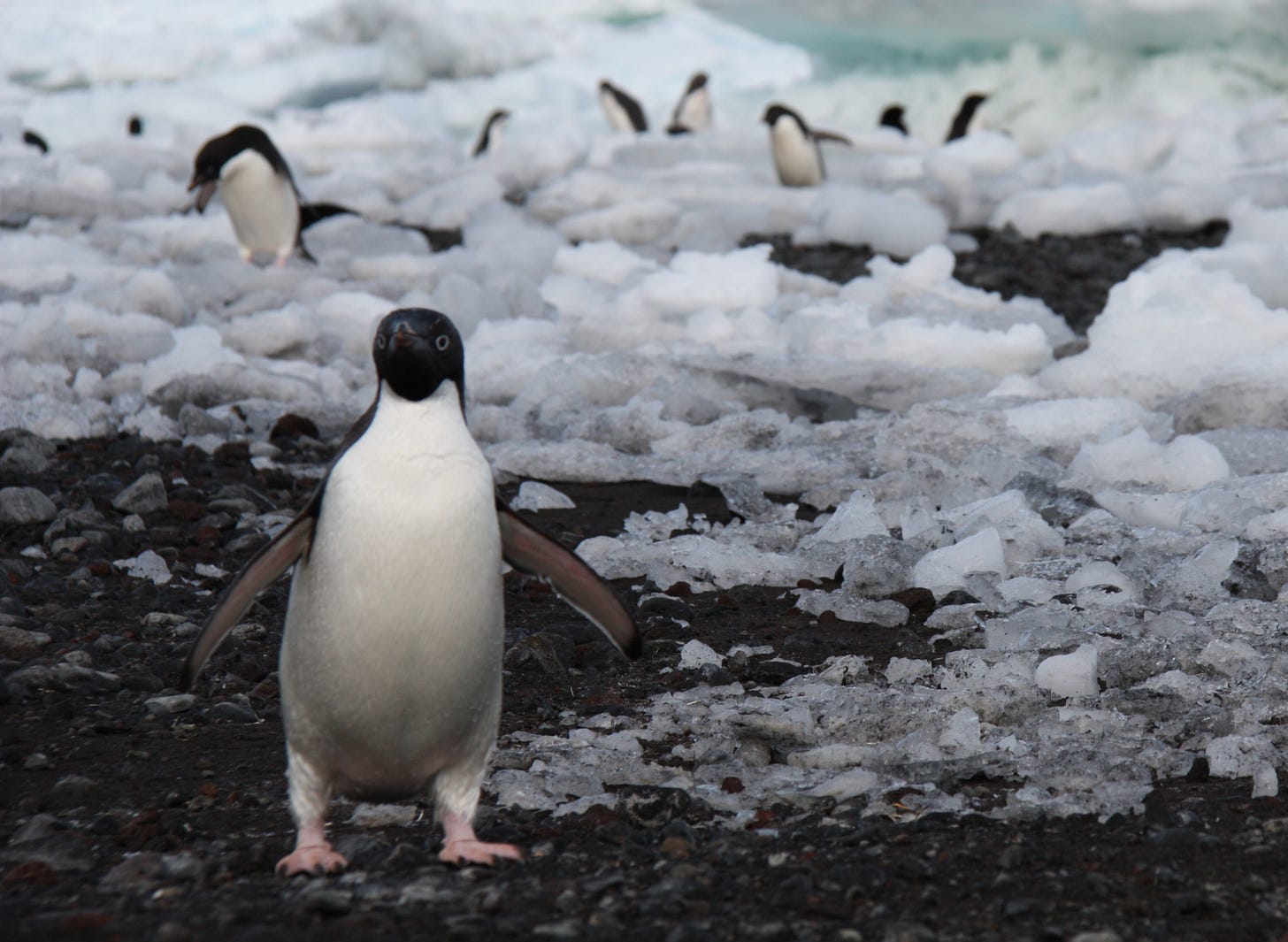There’s a line that divides elegance and absurdity, and it is precisely the width of a penguin. Dapper in black and white, evolution appears to have failed them as they move about on land (click the link, it’s hilarious). A penguin nest appears as inviting as a pillow of bricks, despite being artistically arranged on pink and white marbled rock. A penguin’s call sounds like laughter on the edge of hysteria. And then, when they reach the water, they transform from bumbling buffoon to athlete. It’s like discovering that the awkward kid who mumbles and looks at his feet when he speaks has a celestial singing voice.
But when you bring tens or even hundreds of thousands of penguins together, their individual charisma is overwhelmed. Even in sub-zero temperatures, their colonies reek of ammonia and digested fish. The delicately marbled rock is actually a buildup of their droppings, it’s coloured pink because they feed on krill. And since penguins can return to the same sites to breed for hundreds or even thousands of generations, there can be a lot of droppings. Somewhere like New Zealand, it’s not a big issue, as rain will disperse it, microbes decompose it and plants will grow strong and healthy on it. But on somewhere like Ross Island, where the annual precipitation (total moisture landing as both rain and snow) is similar to the Australian desert, the droppings are just going to sit there, accumulating, year after year. In fact, there’s so much of them, they can be seen from space.
I was curious and tried to get an indication of the volume of droppings that penguins can produce – it seemed like a worthy endeavour for someone who once calculated the daily droppings of New Zealand’s cattle and sheep. I ended up down an odd but entertaining research rabbit hole. The first paper I spotted on penguin poo was co-authored by Craig Cary, whose work I wrote about a few weeks ago. Not surprisingly, it was an investigation into the microbes in an Adelie penguin’s gut. Intriguing, but not useful for my question. Then I discovered that some scientists had observed the way that penguins are able to squirt their droppings some distance, and decided to calculate the rectal pressure required to achieve such a feat. They had won an Ig Nobel prize for their work (this was the same year that a New Zealand researcher won an Ig Nobel prize for a fascinating article about exploding trousers). But they didn’t calculate the volume of the droppings. Nor did the researchers who did followup work on the subject twenty years later.
I spent some time wading through penguin droppings in a non-literal fashion before I thought I might have to extrapolate from other birds. I found a study from someone who was looking at birds on power lines and spent a lot of time looking at bird droppings. But then I stumbled upon a study on Magellanic penguins, a medium-sized species from South America. The study found that wild birds pooed on average every 17 minutes. But they couldn’t measure the volume of droppings for wild birds, so they studied captive birds and found that they pooed on average every 18.5 minutes and produced around a gramme of droppings each time. That works out to around 74 grammes each per day. The Cape Bird colony I was lucky enough to see had an estimated 43,000 birds, adding up to more than 3000 kilos of droppings a day.
All of this is something of a diversion, but penguin droppings were on my mind because bird droppings are one of the main ways that bird flu (or avian influenza) spreads. In February, bird flu was detected in Antarctica for the first time. And this month, for the first time, bird flu was detected in penguins in South Georgia. Technically, South Georgia is considered sub-Antarctic – it’s at a similar latitude to the southern tip of South America and is 1300 kilometres from of the Antarctic Peninsula. But it’s incredibly remote, and the thought that the deadly strain of bird flu which has devastated bird populations around the world was close to Antarctic penguins had me really worried.
I wrote about bird flu nearly a year ago, and it was a disturbing story. Dangerous forms of the bird flu virus, known as “highly pathogenic” because they cause severe disease, have been spreading around the world and killing large numbers of wild birds. These forms of the virus have most recently spread through South America.
Now that they are reported from South Georgia, I’m wondering about the threat to penguins and other Antarctic wildlife. How much of a problem is it likely to be? I’m also wondering about other threats to penguins. Is climate change having an impact on these remarkable birds?
Scientists debate exactly how many species of penguin there are, but it’s somewhere around 18. New Zealand has six species, four of which are found nowhere else, and Antarctica has five species, three of which are confined to the very northern tip of the Antarctic Peninsula. There are also many species of penguins which are known only as fossils, and became extinct long before humans evolved. Only one species, the Chatham Island crested penguin, which looked like a larger version of the Fiordland crested penguin or tawaki, has become extinct due to humans. However, there used to be two other varieties of the hoiho or yellow-eyed penguin, one from the Chathams and one found around both the North and South Islands, and these also became extinct after humans arrived.
Now, though, Birdlife International reports that half of the surviving penguin species are threatened. There are a number of different reasons they are under threat. The three species which breed on the main islands of New Zealand, hoiho, kororā or little penguin, and tawaki are threatened by the usual suspects, introduced mammals such as stoats, rats and cats. So are Galapagos penguins. But on the whole introduced species are not the main threat to penguins.
One of the major threats is loss of breeding areas. Coastal development is a threat to many species. The hoiho, for example, nests in forest, but much of the coastal forest around New Zealand has been turned into towns or pasture. Breeding areas for the Humboldt penguin of South America were damaged by guano harvesting. As I mentioned earlier, a colony of penguins produces a staggering quantity of droppings. So, too, do other seabirds. Over thousands of years, the droppings build up to form deep deposits of dried droppings, known as guano. In areas with lots of rainfall, a lot of the nutrients are washed away, but in dry areas, the nitrogen in the guano remains, and it can be used as fertiliser. In the late 1800s, a huge amount of guano was mined for fertiliser and it damaged the habitat of the Humboldt penguins.
Fishing is another major threat to penguins. They are threatened both by being caught in nets and by declining fish numbers resulting from overfishing. For some species, too, pollution is a serious problem. The biggest problem is oil getting into the sea, because it affects the waterproof feathers which allow penguins to swim so well. Even in remote areas, penguins can be killed by becoming entangled in plastic waste such as old nets.
The extent to which each of these factors affects each species is different, but it adds up to a worrying picture.
Then, there is the climate. Major climate fluctuations, such as El Niño, can affect food supplies. El Niño affects the Humboldt current, which brings nutrients up from the sea floor and nourishes a highly productive area of ocean off the South American coast. The effects of El Niño on the current mean that there is less food available. The 1982/83 El Niño resulted in a massive drop in Humboldt penguin numbers. These are natural cycles, and it’s likely that there were always major fluctuations in penguin populations as a result of fluctuating food supplies. The difference now is that penguins are also threatened by loss of breeding areas, fishing and pollution.
What about climate change? Will that affect penguins? The answer is that it’s affecting them already. When I first wondered about climate change and penguins, I was thinking of Antarctic species, but when I started looking, I discovered that climate change is a threat closer to home. The warming of the ocean around New Zealand is reducing the breeding of some of the fish that hoiho feed on. As a result, climate change is one of the major threats to hoiho. Sea temperatures also affect kororā – warmer temperatures are linked to them getting less food, meaning that climate change may affect them as well.
But the situation is far more dire in Antarctica. Emperor penguins breed mostly on fast ice, which is stable sea ice attached to the coast. They mainly forage within pack ice, which is sea ice drifting under the influence of the wind and currents. Variations in the sea ice influence emperor penguins directly, by affecting breeding and feeding areas. These variations also affect the prey of the emperor penguin, fish, squid and krill.
With climate change, sea ice is forming later, which can delay the breeding of emperor penguins. The fast ice can also break away from the land earlier in the season, destroying breeding sites before the penguins have finished raising their chicks. Some areas where emperor penguins used to breed are becoming increasingly unsuitable, from Halley Bay in the Weddell Sea to Cape Crozier on Ross Island (where Apsley Cherry-Garrard, Edward Wilson and Birdie Bowers collected emperor penguin eggs, as described in the classic Antarctic exploration book The Worst Journey in the World). Some years, the penguins are able to breed. Some years, the sea ice conditions mean that breeding is reduced or even fails completely at some colonies.
It isn’t going to get better. Exactly what it means depends in part on our actions. But, whatever we do, the emperor penguin will be in trouble over much of the area it lives by 2050. By 2100, it will be in serious trouble everywhere, unless we manage major reductions in emissions.
Now, there is bird flu. In fact, it was already a problem for penguins well before the detection on South Georgia. In 2019, African penguins in Namibia died in unusually high numbers. Research showed that they were infected with dangerous forms of bird flu. Scientists are now testing to see whether vaccines could be used to protect them. Other species, such as gentoo penguins, may be under threat too. They are a widespread species and not one of the penguin species considered to be in trouble. But finds of dead gentoo penguins which test positive for bird flu are disturbing.
With bird flu, it is hard to tell what the effects will be. But for penguins, it’s just another threat on a long list of threats, from habitat destruction to climate change. If we value these birds, we need to think about all these threats if we want to keep them safe.









"There’s a line that divides elegance and absurdity, and it is precisely the width of a penguin."
That's the best opening line I've read all year.
Thank you for your continued research into all the corners of the natural world.
Poor Penguins 😔